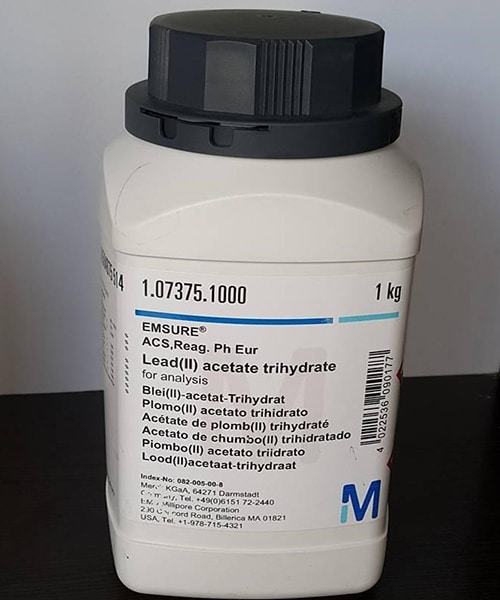Description
This post is also available in:

Lead(II) acetate trihydrate
Catalogue Number |
107375 |
CAS number |
6080-56-4 |
Chemical Formula |
(CH₃COO)₂Pb * 3 H₂O |
Molar Mass |
379.34 g/mol |
Pack size |
250g 1Kg |
Structure formula Image |
Description
Lead(II) acetate (Pb(CH3COO)2), also known as lead acetate, lead diacetate, plumbous acetate, sugar of lead, lead sugar, salt of Saturn, or Goulard’s powder, is a white crystalline chemical compound with a sweetish taste. It is made by treating lead(II) oxide with acetic acid. Like other lead compounds, it is toxic. Lead acetate is soluble in water and glycerin. With water it forms the trihydrate, Pb(CH3COO)2·3H2O, a colourless or white efflorescent monoclinic crystalline substance.
The substance is used as a reagent to make other lead compounds and as a fixative for some dyes. In low concentrations, it is the principal active ingredient in progressive types of hair colouring dyes. Lead(II) acetate is also used as a mordant in textile printing and dyeing, as a drier in paints and varnishes, and in preparing other lead compounds. It was historically used as a sweetener and for cosmetics.
Lead(II) acetate solution was a commonly used folk remedy for sore nipples. In modern medicine, for a time, it was used as an astringent, in the form of Goulard’s Extract. Lead(II) acetate has also been used to treat poison ivy.
Lead(II) acetate paper is used to detect the poisonous gas hydrogen sulfide. The gas reacts with lead(II) acetate on the moistened test paper to form a grey precipitate of lead(II) sulfide.
This post is also available in:





Reviews
There are no reviews yet.